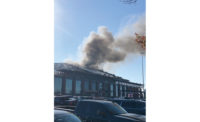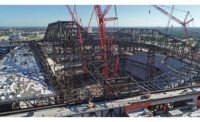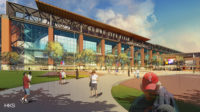The city of Arlington is nestled between Dallas and Fort Worth. It is home to about 380,000 residents, the Texas Rangers baseball team, the Dallas Cowboys and a flurry of construction activity. Nearly $3.32 billion has been invested in Arlington’s economy in projects that were either under construction, approved or completed during 2017. Still more new projects have been announced, so the building boom is likely to continue.
The biggest project rising in Arlington is the $1.1-billion Globe Life Field, owned by the city of Arlington and the future home of the Rangers. Alongside the ballpark is a new mixed-use development dubbed Texas Live! The $250-million project aims to fill the space between Globe Life Field and AT&T Stadium with an entertainment district that replaces surface parking lots.
Arlington also boasts a booming industrial sector and a thriving student housing market. The robust development activity and the city’s unique approach to managing construction on major projects such as Globe Life Field have led ENR Texas & Louisiana to select Arlington as Owner of the Year.
According to Bruce C. Payne, economic development manager at Arlington’s Office of Economic Development, the active construction market across the city can be attributed to three things.
“One, of course, has to do with the Rangers’ decision to move forward with a new ballpark,” he says.
Another engine of growth is the University of Texas at Arlington, located in the downtown area. “They’ve got about 58,000 total students at this point, and 42,000 of those are on-campus students, so developers have come in and are building student housing like crazy,” Payne says. “These are coming along in $40- million to $50-million projects. Some of it is just market-rate, mixed-use rentals, and others are dedicated student-housing projects.”
The third key factor is Arlington’s general location within the Metroplex, including its proximity to major interstate highways and DFW airport, which helps to drive an enormous amount of industrial construction.
Construction Everywhere
However, that activity also requires infrastructure improvements. The city has nearly $110 million in road reconstruction underway, while the Texas Dept. of Transportation is building a $250-million interchange between I-30 and Highway 360.
“We’ve seen somewhere close to 7 million sq ft of new industrial space happen in the last four years.”
– Bruce C. Payne, Economic Development Manager, Office of Economic Development, City of Arlington
“We’ve seen somewhere close to 7 million sq ft of new industrial space happen in the last four years,” Payne says.
Part of that growth is being driven by a $1.4-billion expansion and renovation of a General Motors assembly plant, a project that will expand the automaker’s full-size SUV manufacturing facility by 1.2 million sq ft. Work began in 2015 and is expected to wrap up this year.
A related project is the $250-million Arlington Automotive Logistics Center, located just a mile from the GM plant. Northpoint Development is leading work on the facility, which consists of two industrial manufacturing and warehouse buildings that span more than 1.2 million sq ft. The site was previously home to Six Flags Mall, which was torn down and redeveloped, and includes several adjacent properties.
Understanding What Is Needed
“From a planning and zoning and an infrastructure standpoint, we definitely had some challenges getting from the condition that the site was in to the condition that the site needed to be in to support the planned use,” explains Chad Meyer, president, NorthPoint Development. “The city made some pretty aggressive commitments from infrastructure and permitting, and commitments to help us offset some of the extraordinary costs. We’ve worked with plenty of cities, but Arlington definitely understood what was needed and put the resources in place and made a commitment from the staff standpoint to make sure that we could meet our timelines.”
That leadership helps attract companies to build in the city. “Local government has a key role in facilitating new projects as well as redevelopment, and so if you have a local government that has the ability to forge a strong partnership, with good, solid reputable developers, the results can be just outstanding,” Payne says. “And I think that’s what we’ve been able to do. We get involved to make sure that [a project] comes out and not only meets the needs of the developer and his financial backers but also meets the needs of the community.”
Arlington is an older city; most of its land has been developed and its infrastructure is aging. As a result, the city must provide new infrastructure to support new projects, Payne explains.
“There’s always complications with construction, there’s always unknowns that happen, and so the trick is how do we respond to that and how do we help the developer through those moments when things happen that nobody saw in advance,” he says.
Housing the Rangers
Globe Life Field is being built under a partnership between the city and the Texas Rangers. “Arlington has been the home of the Rangers since 1972,” says Rob Matwick, executive vice president of business operations for the team. “Unlike our current ballpark, Globe Life Field will feature a retractable roof. Climate control is one of the big reasons we’re moving forward on the new building, in addition to being able to create new premium areas and experiences for our fans going forward.”
In 2016, voters passed a bond package for $500 million that is paying for part of the construction of the stadium. “The Rangers are financing everything else,” Matwick adds. “The city’s contribution to the new ballpark is capped at $500 million. The current projected project cost is approximately $1.1 billion. Anything above the $500 million is the team’s responsibility.”
The city owns the ballpark, and the Rangers will lease the facility from Arlington, Payne says.
Manhattan Construction is building the ballpark under a construction manager at-risk contract with a guaranteed maximum price. The 40,000-seat, 1.8-million-sq-ft facility is being built on a fast-track schedule to meet a March 2020 opening. The ballpark’s concrete-and-steel structure will be wrapped in glass, architectural precast, stone and metal panels.
“Arlington has a successful formula in place for funding projects like the new ballpark. They’ve proven it with Globe Life Park, our current park—the city’s bonds were paid off years early,” Matwick says.
Additionally, the city was ahead of schedule in paying off AT&T Stadium, the Dallas Cowboys’ venue, but refinanced that debt last year to pay for both facilities at the same time. AT&T Stadium is also city-owned and leased to the Cowboys, Payne notes.
“They’ve proven it time and again that they can do it through the sales tax mechanism primarily, without increasing property taxes to citizens,” Matwick explains.
The number of visitors to Arlington’s entertainment district is estimated at around 14 million a year. Those tourists will help to retire the stadium debt and improve the entertainment district and the city overall, Matwick points out.
Since Texas doesn’t have a state income tax, cities are more reliant on property and sales taxes, Payne explains. “Part of the funding mechanism for the new ballpark has to do with the sales tax,” he says.
In conjunction with the new ballpark, Baltimore-based developer The Cordish Cos. is building the $250-million Texas Live! hotel and entertainment development in partnership with the Texas Rangers and the city. The project will located between the new ballpark and AT&T Stadium, on Johnson Creek. Construction is being led by the joint venture team of Manhattan Con-Real.
Texas Live! will feature 200,000 sq ft of dining and entertainment venues as well as a 5,000-capacity outdoor-events pavilion. Tied to Texas Live! is the flagship Live! by Loews hotel, featuring 300 rooms with 35,000 sq ft of convention, meeting and special event space.
Ideas for development near the Rangers’ ballpark date back to when Globe Life Park opened in 1994, but nothing has moved forward until now. “It was tried a couple times previously. In 1994, there was actually a plan to build around [Globe Life Park], but the ownership group at the time ended up selling the team, and it didn’t happen,” Matwick says. “Then back in 2006-2007, when Mr. [Tom] Hicks had the team, he had a plan for the Glory Park project, which was a very ambitious retail, entertainment, housing project between the ballpark and what would eventually be AT&T Stadium. Then the economy took a downturn, so those plans got scrapped.”
Discussions began in 2014 with Baltimore-based Cordish Cos., considered a leader in sports-anchored development. “Those talks actually began before the prospect of a new ballpark actually existed,” Matwick says. “In fact, we were still a decade away from lease expiration on our ballpark, so we were very clear with Cordish that there’s a possibility if something happened, we might not be here. But Cordish Cos. believed strongly enough in everything here in the entertainment district that it was in their best interest and ours collectively to go forward as partners.”
About a year after Cordish and the Rangers reached an agreement on what would become Texas Live!, voters passed the city’s bond package for the new ballpark. Texas Live! is scheduled to open this fall, about a year and a half ahead of the new ballpark, Matwick says.
Building Boom
In 2016, developer Nehemiah Co. broke ground on the first phase of Arlington Commons, a 10-year project valued at $200 million aimed at revitalizing a portion of Lamar Boulevard. The city of Arlington is working with the developer under a public-private partnership agreement.
“We worked with the developer to acquire as many as four different apartment complexes in Arlington, to vacate those apartment complexes in a humane way, and then redevelop those sites,” Payne explains.
Combined, the four complexes were worth about $12 million on the city’s tax rolls and had about 736 units, Payne says.
“Some of the tenants just left, they felt it was time to go, but then a lot of them that remained tended to be single parents, so the developer worked with a group we have here called Mission Arlington|Mission Metroplex to help find a place for these people to move, which a lot of times meant securing a new lease for them, and then physically moving them,” Payne explains.
“We went through a fairly lengthy process of relocating these tenants and then went through demolition, etc., and we didn’t have a single negative article in the newspaper, we didn’t have a single complaint from any of the tenants. It was an incredible thing.”
The first structure, which contains about 350 units, is now complete, and the developer is starting on the second of the five structures, Payne notes.
“Arlington has a reputation for rolling up its sleeves and getting things done. I know our ownership has said that we’re not sure that we could have done what we’re doing here in any other city in the country because of the positive attitude and willingness to get things done that city leadership has here in Arlington,” Matwick says.
As construction continues on flagship projects across the city, new work already lies ahead in a variety of different forms. For example, in March, the city announced plans for a state-of-the-art, $10-million, 100,000-sq-ft esports stadium for video game competitions. The project would convert the existing Arlington Convention Center into the arena. The city is working with architect Populous and Esports Venues LLC on the venture.
Development around Globe Life Field will likely continue once Texas Live! is complete as well. “Our intent is we’ll let the market sort of dictate, but we don’t intend to stop at Texas Live! We’re going to continue to look for other opportunities to develop around the new ballpark and continue to grow the entertainment district and hope that we can build an environment where you can work, live and play right here in the heart of Arlington,” Matwick says.








